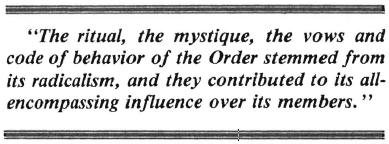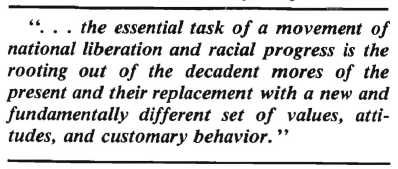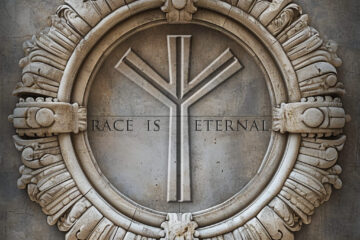Criteria for a White Future
 An Editorial by Dr. William Pierce
An Editorial by Dr. William Pierce
WHEN A SENSITIVE, intelligent, racially conscious White American observes the hellish business of racial and cultural destruction going on all around him, he ordinarily reacts in one of two ways: he becomes involved in one brand or another of conservative or right-wing foolishness; or he tries to shed his sensitivity and retreat into a detached — one might even say solipsist — “observer” status, in which the world around him becomes unreal, like a drama being played out on a giant, panoramic TV screen. (ILLUSTRATION: The Teutonic Order, an example of an organization that encompassed all four criteria to form a functioning “organizational nexus”: hierarchical, radical, all-encompassing, and racial-elitist. They are pictured here fighting the Mongols in 1241.)
Those who choose the latter route will, in most cases, stay with it until an unusually violent and personal bump against reality shatters the carefully cultivated illusion that what’s going on in the world doesn’t involve them and isn’t their responsibility. Unfortunately, of these persons the ones with the greatest potential value are those clever and resourceful enough to avoid such bumps — whether a rape or a quota-related promotion denial or an offspring who becomes a race-mixer — until general economic and social conditions have deteriorated much further than they have at this time.
We have attempted, in two previous editorials, to convince those who have chosen — or are contemplating choosing — the former route that it leads to just as much a dead end as the latter. Specifically, we pointed out in the first editorial two basic flaws in the conspiracy-oriented right-wing approach: namely, the failure to recognize both the magnitude of the problem to be solved and its organic nature. The second editorial pointed out why the masses of the people themselves are incapable of effecting any spontaneous solution, and why any approach relying on education alone is forlorn.
Now we shall examine in detail the one possible route to a White future for this planet. It is, as indicated in last month’s editorial, a route which depends upon the establishment of an organizational nexus: that is, a mental and spiritual connection between a carefully selected minority of the White population and an organizational structure of a very special type. Through this nexus flow the information, the impressions, and the feelings which determine the opinions and attitudes of the selected minority, establishing a consensus which allows the minority to think and act effectively as a unit. The organizational nexus takes the place of the present central nexus and the disrupted village nexus of the past.
Not every organization is suitable for this purpose; as mentioned in the first editorial in this series, the organization which can achieve our purpose must be hierarchical, radical, all-encompassing, and racial-elitist. Consider, for the sake of illustration, a few existing organizations which fail to satisfy some or all of these criteria:
Neither the Republican Party nor the Democratic Party is radical, all-encompassing, or racial-elitist, and their hierarchical structures are only very weakly developed. They are not radical, because they have no purposes or goals rooted in fundamental principles. The “principles” which they do espouse are patently contrived and are subject to instant change to suit the varying needs of each electoral campaign.
They are not all-encompassing, because they address themselves to a quite limited array of issues and provide no guidance at all, even for their staunchest adherents, on those aspects of life outside that limited array. That is, the nexus between the organization and its members is incomplete. The incomplete nexus may provide a consensus on a few narrowly defined issues, but it provides no general consensus, no common world view for the membership.
And it is quite clear that they are not organized along racial-elitist lines. It is a fact that the Republican Party tends to have a much more nearly White membership than the Democratic Party, but that is a fact which the Republicans are desperately trying to change. Both parties are interested solely in the quantity of votes they can muster, and they care not at all about the racial quality of the voters.
The hierarchical structures of the two parties are severely limited in two ways: First, officials are elected by the mass of party members, through a delegate system, and are subject to new elections at frequent intervals. This leads to a strong tendency on the part of the officials to cater to the changing whims of the membership rather than to adhere to any long-term strategy, and it breaks up the continuity of leadership.
Second, authority is fragmented by intra-party rivalries between the stronger candidates for public office, who often establish their own competing mini-hierarchies within the overall hierarchy and think of the party primarily as a vehicle for furthering their own public careers; thus, the party often plays second fiddle to one or more of its own candidates.
The U.S. Army is an organization which satisfies the hierarchical criterion quite nicely, but none of the others. The racial-sensitivity indoctrination to which recruits are now routinely subjected and the occasional servings of democratic ideology dished out along with the military training hardly suffice to qualify the Army as either a radical or an all-encompassing organization.
It may be an all-pervasive physical influence on the lives of its members, but they remain almost as diverse ideologically and spiritually as the members of the civilian population. And it goes without saying that the U.S. Army of today is not racial-elitist, regardless of any tendencies in that direction in the past.
The various Christian churches vary in the degrees to which they satisfy one or more of our criteria. The Roman Catholic Church still has a moderately strong hierarchical structure, although it is yielding more and more to schismatic tendencies and democratic rot. Many of the Protestant churches, on the other hand, are no more hierarchical than the Democratic and Republican Parties.
The Roman Catholics and the Protestant Fundamentalists vie with one another in their degree of radicalism, with some of the more extreme Fundamentalist sects easily edging out the Catholic Church. But other Protestant groups have succumbed to modern, secular tendencies to such an extent that they have a zero radicalism quotient.
During the Middle Ages the Roman Catholic Church came close to being an all-encompassing organization in some parts of Europe, principally in the Mediterranean area. Today it dominates the lives of its members to a far lesser extent in most places, although still more than the larger Protestant sects. A few radical Protestant groups, however, especially those flourishing in geographically isolated or culturally backward areas, still exercise a very strong influence on all aspects of the lives of their members.
Although some of the church-related knightly orders of the Middle Ages may have been de facto racial-elitist (the Teutonic Order, alone of the major orders, was also de jure racial-elitist), all the Christian churches today are strongly anti-racial-elitist and, in fact, collectively present one of the greatest threats to the survival of the White race.
It is dangerous to name any single organization as an example which satisfies our four criteria, because many readers will inevitably see any such organization as a model, to be copied in ways irrelevant, as well as in those ways relevant, to our purpose. The one group mentioned above which does, in fact, meet the four criteria is the Teutonic Order, and it should be kept in mind that, while it is an interesting illustrative example, it is not a model which we want to copy in every detail.
Although the Teutonic Order, as originally conceived toward the close of the twelfth century, was a Christian charitable society, associated with St. Mary’s Hospital in Jerusalem, founded by German Crusaders, it very soon became a military-religious order, with the task of Christianizing, by fire and sword, the heathen peoples of central and eastern Europe. Beyond that it accepted and admirably accomplished the mission of carrying German culture and the German spirit to the eastern marches and transforming them into integral parts of Germanic Europe.
Despite the Order’s later involvement in all the crass commercial and political affairs of the conquered territories, it was not an ad hoc organization; neither money nor politics were motives of its founders. With a transcendent religious zeal and a fervent devotion to what was then perceived as fundamental truth, the Teutonic Order was truly a radical organization.
The ritual, the mystique, the vows and code of behavior of the Order stemmed from its radicalism, and they contributed to its all-encompassing influence over its members: After taking vows of poverty, obedience, and chastity, the Teutonic Knights partook of a semi-monastic lifestyle. They wore a distinctive monk’s habit (white with a black cross) over their armor. When not in the field they lived communally in the castles and fortified houses (Ordensburgen) which they built to rivet down the inexorably advancing frontier of their conquests. Prayers and other monkish pastimes were almost as much a part of their lives as the martial arts.
 The Order, as is necessary in the case of any organization with a military function, was structured hierarchically. A grand master of the Order was chosen for life by the members of what amounted to a general staff. Five members of this general staff formed a permanent ministry, or privy council, which aided the grand master in his executive duties.
The Order, as is necessary in the case of any organization with a military function, was structured hierarchically. A grand master of the Order was chosen for life by the members of what amounted to a general staff. Five members of this general staff formed a permanent ministry, or privy council, which aided the grand master in his executive duties.
Each of the provinces or territories under the Order’s control was organized similarly, with a provincial commander having a provincial council of knights as subordinate officers. Finally, each Ordensburg was under the authority of a commander subordinate to the provincial commander and advised by a council consisting of all the knights belonging to that Ordensburg.
The Teutonic Order accepted as members only Germans of noble birth. As mentioned above, it was the only major knightly order of the Middle Ages which was not cosmopolitan in its membership policy. This represented quite a departure from the policy of a church which clasped to its bosom every baptized Jew and Levantine convert, no matter how dusky his hue.
The Order’s racial-elitism, unfortunately, was not as thoroughgoing as it might have been, since the group’s principal purpose was not so much the racial improvement of the eastern marches as their conversion to Christianity and their Germanization, in the political-cultural sense. In fact, the Order’s rule of celibacy acted dysgenically, resulting in the extirpation of some of Europe’s best genes and contributing to the racial impoverishment of the German nobility.
Nevertheless, the restrictive membership policies, by giving the Order a high degree of racial homogeneity, undoubtedly heightened its esprit de corps and contributed substantially to its military successes. The Teutonic Knights were, indeed, a band of brothers.
During the thirteenth century the Order conquered Old Prussia, and in the following century the Baltic states, extending German rule along the southeastern and eastern coasts of the Baltic Sea and as far up the Gulf of Finland as Narva.
Although Pomerania, the (at that time) Slavic province stretching along the southern coast of the Baltic Sea on both sides of the Oder, had already been Christianized in the twelfth century, the Teutonic Knights played a major role in reshaping its political and cultural destiny during the thirteenth and fourteenth centuries. A similar role was played in the March of Brandenburg, where the Order’s dominating influence reached as far west as the Elbe.
All in all the Teutonic Order significantly and permanently shifted the course of European history and exerted a tremendous military, political, and cultural influence over vast territories, inhabited by millions of people, throughout a period of more than two centuries. The truly astounding aspect of this achievement was the Order’s size: it never had as many as a thousand members.
It more than made up for this lack of numbers in two ways: in the exceptionally high quality of its members and in the organizational nexus which bound the members together. The nexus was complete; the members’ commitment to the organization’s goals was total. Beyond these two things, the organization’s hierarchical structure resulted in efficient decision-making, continuity of purpose, and internal stability.
Conditions in the world have changed mightily since the Middle Ages, but the human condition has not. Although the Teutonic Order itself would be awkwardly anachronistic in today’s world, the fundamental organizational principles which led to its success seven centuries ago remain valid. The achievement of a radical purpose, against a numerically superior opposition, calls for an organization of exceptionally capable, highly motivated, totally committed people able to function in a completely coordinated manner.
Imagine a modern American Order founded for an ad hoc political purpose, say, the forced annexation of Canada to the United States so as to gain control of Canada’s nickel deposits and oil sands; an American Order organized along the lines of the Republican Party, consisting of members signed up by neighborhood canvassers; an American Order like the present U.S. Army, with recruiting brochures stressing that the Order is “an equal opportunity employer” and offering the inducement of foreign travel and free occupational training. Imagine such an American Order setting out to conquer Canada . . . with fewer than a thousand members.
The idea is, of course, laughable.
No ad hoc organization, no organization based purely on self-interest, no organization structured democratically, and no organization composed of the same number of average citizens could have accomplished what the Teutonic Order did — nor can it accomplish what we must.
For continuity of purpose during a long struggle, for unwavering concentration on long-range goals through periods of adversity, for winning and holding members with the requisite personal characteristics, for resisting centrifugal tendencies and internal subversion, and for evoking the degree of individual commitment necessary to overcome an enormous numerical disadvantage, the four organizational criteria cited above must be met.
There is also another compelling reason why a complete organizational nexus is necessary. People recruited from the U.S. civilian population, even the most intelligent people, are inevitably under the influence of the prevailing mores. The values and attitudes of the larger society bias their outlooks. In particular, popular taboos inhibit the acceptance of some of the harsher revolutionary realities and the carrying out of necessary actions.
This was not a problem for the Teutonic Order. Its members were not required to act in contravention of established taboos. The values and teachings of the Christian church in that more virile era were perfectly consonant with using any necessary degree of force to convince pagans of the error of their ways. Nor were the Teutonic Knights attempting to change the existing moral order in any way; they wanted only to increase the number of souls subject to it.
In America, on the other hand, the essential task of a movement of national liberation and racial progress is the rooting out of the decadent mores of the present and their replacement with a new and fundamentally different set of values, attitudes, and customary behavior. Unless the adherents of such a movement — especially its cadres — have themselves undergone this process of spiritual renewal, there is little chance that they will be able to bring about such a change in the larger society, regardless of any temporary political or military successes they may achieve.
 And the only way that a movement’s members can reasonably be expected to shed their old values and attitudes and assimilate new ones is through a complete organizational nexus. A little optional reading for new members is insufficient. Instead, each member must become completely involved with the ideas and the activities of an organization, not only reading and studying all the organization’s publications, but also discussing them with others, attending meetings, distributing leaflets and newspapers publicly, and otherwise devoting a substantial portion of each day to this involvement.
And the only way that a movement’s members can reasonably be expected to shed their old values and attitudes and assimilate new ones is through a complete organizational nexus. A little optional reading for new members is insufficient. Instead, each member must become completely involved with the ideas and the activities of an organization, not only reading and studying all the organization’s publications, but also discussing them with others, attending meetings, distributing leaflets and newspapers publicly, and otherwise devoting a substantial portion of each day to this involvement.
Only in this way will the new values and attitudes gradually replace the old ones, with the member becoming more and more confident in his understanding of the new world view and basing his daily decisions on it more and more naturally and unconsciously. And, thus, it is clear that, for this process to take place, not only must the organization be radical (i.e., fundamental in its treatment of issues), but it must also have an all-encompassing approach to the world and to its members.
* * *
From Attack! No. 66, 1979, transcribed by Anthony Collins and edited by Vanessa Neubauer, from the book The Best of Attack! and National Vanguard, edited by Kevin Alfred Strom






Like the article very much, But who heads up National Alliance now?
The Alliance is now headed by Chairman Will Williams. See:
http://en.metapedia.org/wiki/Will_Williams
and
http://natall.com/about/what-is-the-national-alliance/
Interesting read which sets out the requirements for White leadership in the war for the continuation of our people. If you ignore the deeply insulting veneration of teutonic knights which butchered half of Europe to eradicate our native culture and political representation system therein for the Jew worshippung slave cult of Christianity. As if they are a pfime example of the racial organisation we need to save us. The article speaks in great detail of flaws with existing bodies of power that do not represent Whites or serve our interests. To then ignore the alien, Jew nature of Christianity and the organisations which butchered our people in uts name. Obviously Christian organisation have never, can never and will never be representative or succesful for the plight of Europeans. Where even… Read more »
GENERAL PRINCIPLES A Natural Order We see ourselves as integral with a unitary world around us, which evolves according to natural law. In the simplest words: There is only one reality, which we call Nature: not the “my reality” and “your reality” of the subjectivists and not the separate spiritual and physical realms of the supernaturalists. We are a part of Nature and subject to Nature’s laws. Within the scope of these laws we are able to determine our own destiny. If we err in our efforts there is no one to protect us from the consequences of our folly or our weakness. In other words, we ourselves are responsible for everything over which we have the power of choice: in particular, for the state of our environment and for… Read more »